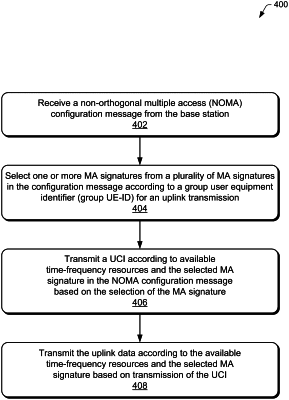| CPC H04W 72/21 (2023.01) [H04L 5/0037 (2013.01); H04L 5/0048 (2013.01); H04W 8/22 (2013.01); H04W 74/0833 (2013.01); H04W 72/044 (2013.01)] | 20 Claims |

|
1. A method for communicating with a base station by a user equipment, the method comprising:
receiving a non-orthogonal multiple access configuration message from the base station, the non-orthogonal multiple access configuration message including a plurality of multiple access signatures and available time-frequency resources for uplink transmissions;
deriving a group user equipment identifier (a group UE-ID) from at least a user equipment-specific identifier (a UE-specific ID) assigned to the user equipment, the group UE-ID corresponding to a group of user equipments that includes the user equipment;
while operating in a radio resource control inactive (RRC inactive) state or a radio resource control idle (RRC idle) state, selecting, for at least a first uplink transmission, a multiple access signature from the plurality of multiple access signatures;
transmitting, using an uplink control channel, uplink control information in the first uplink transmission using a first time-frequency resource of the available time-frequency resources and the selected multiple access signature; and
transmitting, using an uplink data channel, uplink data in a second uplink transmission using a second time-frequency resource of the available time-frequency resources and at least based on the uplink control information.
|